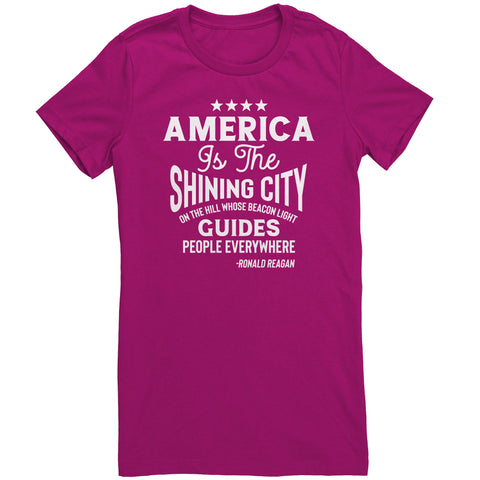Explore Brown County: A Shining City on a Hill Experience

Explore Brown County: A Shining City on a Hill Experience
The phrase 'a shining city on a hill' has echoed through American history, capturing the nation's ideals and aspirations. It is a powerful image, often invoked in political rhetoric, that has shaped how many view the United States and its place in the world. But what does this evocative phrase truly mean, and why does it continue to strike such a resonant chord, even in communities like Brown County, Indiana?
This iconic phrase has roots extending deep into America's earliest colonial past, yet it continues to hold significant meaning today. It speaks to enduring hopes, deeply held values, and the vision of the kind of country many strive to build and maintain. Let's explore the origins of this idea, its evolution through centuries of American experience, and how it connects to the heart of America in places like Brown County.
Table Of Contents:
- The Birth of an American Vision
- From Puritan Dream to Political Ideal
- More Than Just Words: A Call to Action
- Why It Still Matters Today
- Brown County: A Small Town Reflecting Big Ideals
- Living the Values in Brown County
- Small Town, Big Impact
- Wearing the Message: Brown County Pride
- More Than Just a Souvenir
- Conclusion
The Birth of an American Vision
The story of 'A Shining City on a Hill' begins not in the established United States, but on the high seas, long before the nation's formal founding. Its genesis lies with John Winthrop, a Puritan leader and a key figure in the establishment of the Massachusetts Bay Colony. In 1630, aboard the ship Arbella as it sailed towards the New World, Winthrop delivered a lay sermon titled 'A Model of Christian Charity.'
In this foundational speech, Winthrop articulated a profound vision for the Puritan settlers, suggesting they had a unique and divinely ordained mission. He famously stated, 'For we must consider that we shall be as a city upon a hill, the eyes of all people are upon us.' This image, drawn from the Sermon on the Mount in the Bible where Jesus calls his followers to be a light for the world, was intended to inspire and caution the colonists of the Massachusetts Bay.
Winthrop emphasized that their success or failure in creating a godly community in the bay colony would be closely watched by the world, serving either as an exemplar of Christian virtue or a testament to their shortcomings. He warned that if they were to 'deal falsely' with their God in this endeavor, they would invite divine wrath and become a cautionary tale. The original text of his sermon, versions of which the Massachusetts Historical Society published, outlines this covenantal relationship, a cornerstone of their political life and spiritual aspirations. For those interested in deeper research, resources like the Massachusetts Historical Society offer valuable archives, and scholars like Abram Van Engen have explored this concept extensively, sometimes through works available from a university press such as Harvard University Press or Oxford University Press. Winthrop, considered by some as America's forgotten founding father, laid a foundation for what would later evolve into discussions of American exceptionalism.
The governance of the colony, through bodies like the General Court, was intended to uphold these ideals, though the reality often involved complex challenges. The idea that the new settlement in Massachusetts Bay had a special destiny and a heavy responsibility began to permeate the colonial consciousness, gradually shaping an early form of American identity long before the Revolutionary War. The notion of America as a beacon, an example to other nations, was thus planted early in its soil.
From Puritan Dream to Political Ideal
For centuries, Winthrop's specific phrasing remained primarily within theological and historical discourse. However, the 'city on a hill' concept saw a significant resurgence in modern American political life, largely popularized in the 20th century. President-elect John F. Kennedy, in an address to the Massachusetts General Court on January 9, 1961, invoked Winthrop's words, connecting his impending presidency to this historical vision of duty and high purpose.
Yet, it was President Ronald Reagan who most effectively and frequently brought the phrase 'shining city on a hill' into the national and international spotlight. Throughout his political career, from gubernatorial speeches to presidential addresses, Reagan used this imagery to encapsulate his vision of American exceptionalism and its role as a global champion of freedom, particularly during the Cold War. He envisioned a nation that was a beacon of hope and liberty, influencing foreign policy by its very existence and principles.
In his poignant farewell address in January 1989, President Ronald Reagan painted a particularly vivid picture of this ideal. He described the 'shining city' as he had spoken of it all his political life: 'a tall, proud city built on rocks stronger than oceans, wind-swept, God-blessed, and teeming with people of all kinds living in harmony and peace.' He imagined a city with free ports, where 'the doors were open to anyone with the will and the heart to get here.' This farewell speech cemented the phrase in modern political lexicon.
The use of this metaphor did not end with Reagan. Other prominent figures have adapted it. For instance, Barack Obama often referenced the 'city on a hill' in speeches, including commencement address deliveries, emphasizing the ongoing American experiment and the responsibility to live up to its ideals. Mitt Romney, during his presidential campaign, also utilized the imagery to project American strength and moral leadership. Even presidential candidate Donald Trump has, at times, alluded to similar notions of American greatness, though perhaps with a different emphasis, reflecting the phrase's enduring malleability in political rhetoric. The phrase has appeared in various contexts, from an election eve address to broader discussions of the American dream. Researchers can explore many of these speeches through archives like the American Presidency Project at UC Santa Barbara, sometimes finding transcripts or recordings, and for older materials, tools like the Wayback Machine can be invaluable. Scholars like Abram Van Engen from Yale University continue to study the evolution of this phrase.
Here's a look at how some leaders have interpreted this vision:
| Figure | Context | Interpretation/Emphasis | Associated Concepts |
|---|---|---|---|
| John Winthrop | 'A Model of Christian Charity' (1630) | A covenantal community, moral exemplar, subject to divine judgment, must not deal falsely. | Christian charity, original text, Massachusetts Bay Colony. |
| John F. Kennedy | Eve Address to Massachusetts General Court (1961) | Civic responsibility, idealism, global example, high standards for public service. | President-elect John, political life. |
| Ronald Reagan | Farewell Address (1989) and throughout presidency | American exceptionalism, freedom, economic prosperity, 'peace through strength,' a welcoming nation with doors open. | Farewell speech, President Ronald, Cold War, city built on rocks stronger, kinds living, free ports. |
| Barack Obama | Various speeches, including commencement addresses | An ongoing journey, striving for ideals, inclusivity, shared destiny, global cooperation. | Commencement address, American dream. |
| Mitt Romney | Presidential Campaigns | American leadership, economic strength, defense of liberty, moral purpose. | Republican presidential candidate. |
| Donald Trump | Campaign rallies and presidential speeches | National greatness, 'America First,' economic renewal, strong borders, sometimes critiquing past globalist interpretations. | Presidential candidate Donald Trump, city walls. |
More Than Just Words: A Call to Action
A Shining City on a Hill' is far more than an eloquent metaphor; it serves as a persistent challenge to Americans to embody their highest ideals. It calls for the continuous construction of a society that merits global admiration – a place characterized by genuine freedom, widespread opportunity, and impartial justice for all its inhabitants. This vision demands leadership that extends beyond mere power, encompassing moral character and integrity in its foreign policy and domestic affairs.
It suggests that America's primary influence should stem from its example, demonstrating to the world the possibilities that arise when a diverse populace commits to liberty, democratic principles, and mutual respect. However, this concept does not imply a claim of inherent perfection. The 'shining city' is perpetually a work in progress, acknowledging national flaws and historical missteps, including the dark periods of civil war, while simultaneously urging citizens to strive for constant improvement and to avoid becoming a nation where the Puritans failed in their aspirations for a just society. It also raises questions about who is included within the 'city walls' and whether its beacon is truly visible to all, or if some remain outside, unable to share in its promise. This differs from the more expansionist connotations sometimes associated with manifest destiny, focusing more on internal character than territorial ambition.
Why It Still Matters Today
In our contemporary world, fraught with complex global challenges and increased awareness of domestic shortcomings, the idea of America as a 'shining city on a hill' might seem anachronistic or even arrogant to some. We are more conscious than ever of our nation's historical and ongoing problems, from social injustices to political polarization. Yet, it is precisely because of these challenges that the concept, when rightly understood, retains its importance and relevance. Many scholars, including Richard Gamble, have critically examined the phrase derived from Winthrop and its historical usage, contributing to a nuanced understanding. Such scholarly works are often found through resources like Oxford University Press or other academic publishers.
The 'shining city' serves as a reminder not of achieved perfection, but of aspiration – what we are collectively aiming for. It is not fundamentally about asserting superiority over other nations, but about setting exceptionally high standards for ourselves and diligently working to meet them, learning from both successes and failures. This powerful idea can act as a unifying force, rallying citizens around shared core values like freedom, equality, the pursuit of happiness, and the importance of personal qualities like resilience and compassion. It encourages a focus on common purpose, urging us to look beyond our differences and collaborate in building a more just and prosperous society. Information about these ideals can even be found in widely accessible resources like a free encyclopedia, though deeper historical context often requires more scholarly sources such as those found at the New-York Historical Society.
Brown County: A Small Town Reflecting Big Ideals
How does this grand, national narrative connect to a place like Brown County, Indiana? This charming Midwestern community, nestled among rolling hills, might seem worlds away from the lofty pronouncements of presidential candidates or the foundational declarations of a forgotten founding father. Yet, in many tangible ways, Brown County embodies the quiet, lived-in spirit of the 'shining city on a hill' through its community actions and values.
Brown County is renowned for its breathtaking natural beauty, particularly during the autumn months when the forested hills explode in a symphony of color. But its appeal extends far beyond its picturesque landscapes. It is a community that deeply values independence, fosters creativity, and actively practices a neighborly spirit that can sometimes feel lost in more urbanized settings. These personal qualities are woven into the fabric of daily life here.
The county's history is rich with examples of people uniting to create something special and enduring. In the early 1900s, drawn by Brown County's unique beauty, artists began to arrive, eventually forming the Brown County Art Colony. They established a vibrant cultural scene that not only thrived but continues to flourish today, enriching the lives of residents and visitors alike.
During the Great Depression, a period that tested the mettle of communities nationwide, Brown County residents demonstrated remarkable resilience and ingenuity. They banded together to navigate severe economic hardship, often relying on systems of bartering and mutual aid. This enduring spirit of self-reliance coupled with strong community support remains a defining characteristic of the county. These historical narratives might be explored further via local historical societies or even through broad research accessible through search engines, occasionally archived by projects like the Wayback Machine.
Living the Values in Brown County
Brown County's many annual events and community traditions serve as vibrant showcases of its commitment to enduring American values. The Fourth of July parade in Nashville, the county seat, is more than just a festive occasion; it is a heartfelt reaffirmation of patriotism and community pride. Local veterans are given places of honor, and the entire town participates, waving flags and celebrating their shared heritage and freedoms.
The county's dedicated approach to historic preservation offers another compelling example. Residents work diligently to maintain the unique architectural character and historical integrity of their towns and structures, even as they embrace thoughtful progress and necessary modernization. They understand that being a community that shines involves honoring one's roots while adaptively moving towards the future. This commitment to heritage is something the historical society published materials might detail.
Brown County's thriving and diverse arts scene embodies the cherished American ideal of free expression. From painters and sculptors to musicians and writers, creative individuals find a welcoming and supportive environment here. It is a place where individuality is not just tolerated but actively celebrated, and where new ideas and artistic endeavors are warmly welcomed. This commitment to openness and creativity helps make the community a small beacon, reflecting the larger national aspiration of being a city free for all its inhabitants.
Small Town, Big Impact
One might reasonably wonder how a relatively small county in the heart of Indiana can meaningfully reflect such grand national ideals typically associated with presidential campaigns or the original text of Winthrop's vision. But therein lies the inherent beauty and accessibility of the 'shining city' concept. It is not ultimately about geographical size, economic power, or political dominance; it is fundamentally about values and how these values are lived out daily by ordinary people in their communities.
In Brown County, the sense of community is palpable; people generally know their neighbors and look out for one another. Residents actively volunteer their time and talents at local schools, community centers, and places of worship. They make a conscious effort to support local businesses, understanding that this patronage strengthens the local economy and preserves the unique character of their home. These actions, though they might seem small on an individual level, are precisely the kinds of personal qualities and civic engagements that form the foundational building blocks of any 'shining city,' whether large or small.
This county, with its unique blend of natural splendor and community spirit, demonstrates that one does not need to be a sprawling metropolis or a center of federal power to serve as a beacon of hope and positive example. Sometimes, the most inspiring lights, reflecting the best of the American dream, shine brightly and with great clarity from the most unexpected of places. Ryan Teague Beckwith, a journalist known for political analysis (though often seen as Ryan Teague in some contexts for brevity), might observe such local phenomena as reflections of broader national trends.
Wearing the Message: Brown County Pride
Now, there is a tangible way to carry a piece of this 'shining city' spirit, as embodied by Brown County, with you. Brown County Souvenir has thoughtfully created a special t-shirt, inspired by this powerful and enduring American ideal. It seeks to capture a little of that light for those who appreciate what the community represents.
The 'Shining City on a Hill' t-shirt is more than just an article of clothing. It serves as a quiet statement of values, connecting the wearer to the long and significant history of this profound idea, and to the special character of Brown County that reflects these aspirations. It is a subtle nod to the ideas of John Winthrop and the echoes of his vision in the words of leaders like President Ronald Reagan.
Wearing this shirt can be a way to express pride in your community, whether you call Brown County home or are a visitor touched by its charm, and in the broader ideals of your country. It can act as a conversation starter, providing an opportunity to share the story of Brown County and its unique place within the larger tapestry of the American dream. It's a reminder that the concept of a shining city is not just for national leaders but for every community.
More Than Just a Souvenir
This thoughtfully designed t-shirt transcends the category of a typical tourist memento. It offers a way to take home something more profound than just pleasant memories or photographs from a visit. By choosing this item, you are bringing back a piece of Brown County's distinctive spirit and a tangible reminder of the enduring qualities that contribute to making America a special place for many.
The shirt is designed and digitally printed, right in Brown County. Purchasing it directly supports the talented local artists and dedicated small businesses that are integral to the community's vitality and unique character. It is a direct and meaningful way to contribute positively to the community you have come to admire and enjoy.
Whether you are a first-time visitor captivated by the county's allure or a long-time resident deeply connected to its way of life, this shirt allows you to carry the 'shining city' message forward. It serves as a daily, wearable reminder of the values we collectively strive for and the special places, like Brown County, where those values are not just abstract concepts but are actively brought to life through community action and individual commitment. It represents a belief that the 'doors open' vision Reagan spoke of can be found in the welcoming spirit of such towns.
Conclusion
The idea of America as 'a shining city on a hill' has inspired, challenged, and guided generations since John Winthrop first articulated it for the Massachusetts Bay Colony. It is a potent call to action, urging the creation of a society that consistently lives up to its highest professed ideals of liberty, justice, and opportunity. In the heartland community of Brown County, Indiana, we observe a compelling microcosm of how these grand, national dreams can take firm root and flourish in small-town American soil.
From its stunning natural landscapes to its closely-knit and resilient community, Brown County quietly embodies many of the core values that proponents believe make America special. It effectively demonstrates that the 'shining city' is not merely an abstract political vision or a relic of forgotten founding fathers. Instead, it is something actively constructed and nurtured every day through the collective efforts and personal qualities of people in their own local communities, striving to build a city free and fair for all.
The next time you find yourself in Brown County, perhaps taking in the views from a high ridge or strolling through its welcoming towns, take a moment to look around and reflect. You might just catch a glimpse of that inspiring shining city on a hill, not in towering skyscrapers, but in the spirit of its people. And with the Brown County Souvenir t-shirt, you can carry a small piece of that hopeful vision, and Brown County's embodiment of it, home with you, reminding you of the enduring power of community and shared ideals.
















